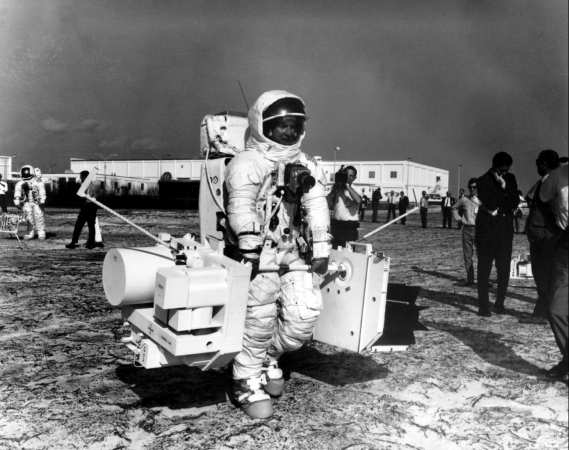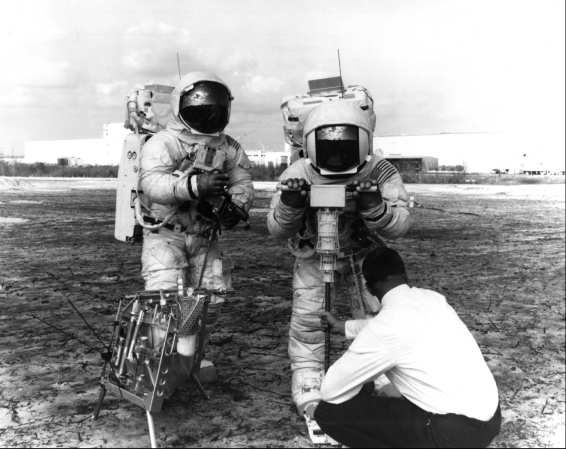
Apollo 14 Launch Operations
The Apollo 14 launch, originally scheduled for February 1970, was postponed to July, then to October, then to December, and finally, after the Apollo 13 review board, was set for 13 January 1971. As Stuart A. Roosa remarked to a press conference, his "was the only crew that's been six months from launch four times."41 The delays allowed the launch team to check and recheck the Apollo hardware, and ensured ample training time for all concerned. Roosa, for example, logged more than 1,000 hours in the command module simulator.
The Apollo 14 command-service module had arrived at KSC on 19 November 1969 and moved into the altitude chamber the following week. the ascent stage of the lunar module was flown down from Bethpage, Long Island, on the 21st; the descent stage followed three days later. When tests in early December revealed a faulty oxidizer flow control valve on the descent stage, a new engine was substituted before Christmas. Operations continued during the holiday season; on the 29th and 30th, North American technicians replaced a defective hydrogen tank in the service module. The first major exercise of the new year involved a successful command-service-lunar module docking test on 9 January 1970. Two days later the S-IC stage sailed into its slip. The Boeing team erected the booster the following day on a mobile launcher. A week later the S-II and S-IVB stages arrived and were placed in low bay stalls. At the operations and checkout building, the descent stage entered the altitude chamber on 16 January. The Grumman team moved the ascent stage to the chamber on the 19th and began a three-day mating operation.
There were no significant problems for the next ten weeks until an accident in mid-April caused about a month's delay. North American's work schedule for the 15th included installation of a new inertial measurement unit with an improved gyroscope. A technician accidentally punched a hole in the unit and a pint of water glycol spilled out over the command module's lower equipment bay. Spacecraft officials initially estimated the cleanup and modification would take nine days. As the North American crew removed wires and equipment, the damage proved more extensive. However, there was no need to rush; the Apollo 13 accident had, by this time, delayed the launch of 14 indefinitely. When the cleanup was completed, a special altitude chamber run was conducted on 15 May to dry out the command module.42
The instrument unit arrived at KSC on 6 May; the following month North American engineers finished modifying the S-II stage's center engine. During the Apollo 13 flight the pogo effect had reappeared, this time on the second stage. Severe oscillations had forced an early shutdown (two minutes ahead of schedule) of the inboard engine. Although the outboard engines had burned longer and compensated for the loss, NASA officials did not want any more pogo. Marshall and North American engineers devised three changes to the second stage. They installed a helium gas accumulator in the LOX line of the center engine. This reservoir served to dampen fluid pressure oscillations, keeping them out of phase with the vibrations of the thrust structure and engines. North American added a cutoff device to shut down the center engine in case the accumulator failed to control the oscillations. Finally, simplified propellant valves were installed on all five J-2 engines. The valves controlled the propellant mixture to the engines, providing a rich mixture for high thrust during the early portion of the burn and a leaner mixture later.43
In the operations and checkout building, the primary and alternate crews conducted altitude chamber runs in the lunar module and simulated the command-service module altitude run. Grumman engineers traced noise problems in the VHF communications system to the VHF transceiver and the signal processor assembly. After replacing the defective parts, the lunar module team scheduled another run for 10 July.
The date for the altitude test slipped several times. Excessive leakage in a propellant quantity gauge caused the first delay. Tests at Houston and Bethpage resolved the problem by late July, and the rerun was set for 13 August. A conflict with the flight crew training schedule led to a second postponement, this time until the 18th. On 11 August, Houston asked KSC to check the ascent stage's ball valves, and on the 17th the Office of Manned Space Flight ordered ball valve leak checks on both stages. The test involved the removal of the lunar module from the altitude chamber to the high bay work stands and separation of the two stages. The spherical valves, located above the ascent and descent engines, controlled the flow of hypergolic fuel and oxidizer into the thrust chamber. The launch team used gaseous helium to test the valve seals. The leak checks and other propulsion system tests were completed by the end of August. On 2 September the lunar module returned to the altitude chamber, where all systems were reverified with an altitude run on 18 September.44
A stretch-out in the Apollo 14 launch schedule had prompted the decision to revalidate the ball valves. In early July, NASA Headquarters released a new flight schedule moving the launch date from 3 December 1970 to 31 January 1971. The postponement was caused by the Apollo 13 review board's recommended modifications for the command-service module. The board added a third cryogenic oxygen tank (placed in a previously empty bay of the service module), an auxiliary battery as a backup to the fuel cell, and an emergency supply of drinking water. The modifications recommended for the oxygen tanks - for example, replacing the Teflon insulation on internal wires with stainless steel conduits - required more time.
Following manned altitude runs in early September, North American removed the command-service module from the chamber on the 17th for cryogenic modifications (to comply with the Apollo 13 review board recommendations). The lunar module remained in the chamber until 13 October, when Grumman began installing the landing gear at the high bay stand. In late October, the launch vehicle team detected a condition that might inhibit S-II separation from the booster; paint on a mating flange had bonded it to the second stage. After the upper stages were removed and the area cleaned, the Saturn was restacked on 2 November. The spacecraft was added on the 4th and rollout followed five days later. Milestones passed in routine fashion the last two months:
- 7 December - Launch readiness review
- 14 December - Space vehicle overall test 1 completed
- 17 December - Flight readiness review
- 19 December - Flight readiness test completed*
- 19 January - Countdown demonstration test completed
- 25 January - Launch countdown begun.45

The difficulties of practicing for work on the moon. (1) Training aids were built much lighter than the actual equipment, to approximate the effects of lunar gravity; but those effects could never be duplicated exactly.

(2) As the scientific tasks became more elaborate, so also did training for making observations on the moon.

(3) Even the simplest tasks were difficult to perform.
The Apollo 14 mission attracted widespread interest, in part because of its predecessor's near disaster, but also because its popular commander, Alan Shepard, was making a comeback after ten years. Following his 15-minute Mercury flight in May 1961, Shepard had been grounded for a minor ear disorder. He had continued in the program, serving for a while as chief of the Astronaut Office at Houston. Flights had passed him by, however, until surgery corrected his ear problem in 1969. Navy Captain Shepard's presence on the team bothered some junior members of the Flight Crew Operations Branch. They feared that Shepard would "pull rank" and prove uncooperative. But as Riley McCafferty recalled:
Shepard eased himself in and, over a period of about four weeks, he had a relationship with the young engineer on the floor that was good. They had a lot of confidence in each other and they talked back and forth; and the instructor, the young engineer, felt like he could tell Al Shepard, "you fouled up, buddy."47There were no mishaps during the last week of Apollo 14 operations. The countdown, begun on 25 January, included 102 hours of scheduled tasks and five holds totaling 48 hours. The amount of intended hold time, representing rest periods and contingency planning for unforeseen problems, had changed little in four years. The holds proved largely unnecessary for Apollo 14. On launch day, 31 January, overcast skies gave Walter Kapryan some anxious moments. Light rain was falling on the large Sunday afternoon crowd when Kapryan halted the count at 3:15 p.m., only eight minutes from launch. Within 40 minutes, the cloud peaks had moved from the flight path. Launch officials changed the flight azimuth of the space vehicle from 72 degrees to 75.6 degrees and sent Apollo 14 on its way.48
* During the flight readiness test, NASA officials received an anonymous telephone call threatening to blow up the launch center. KSC increased its security measures for the count down and launch. Washington Star, 20 Dec. 1970.
| Next |